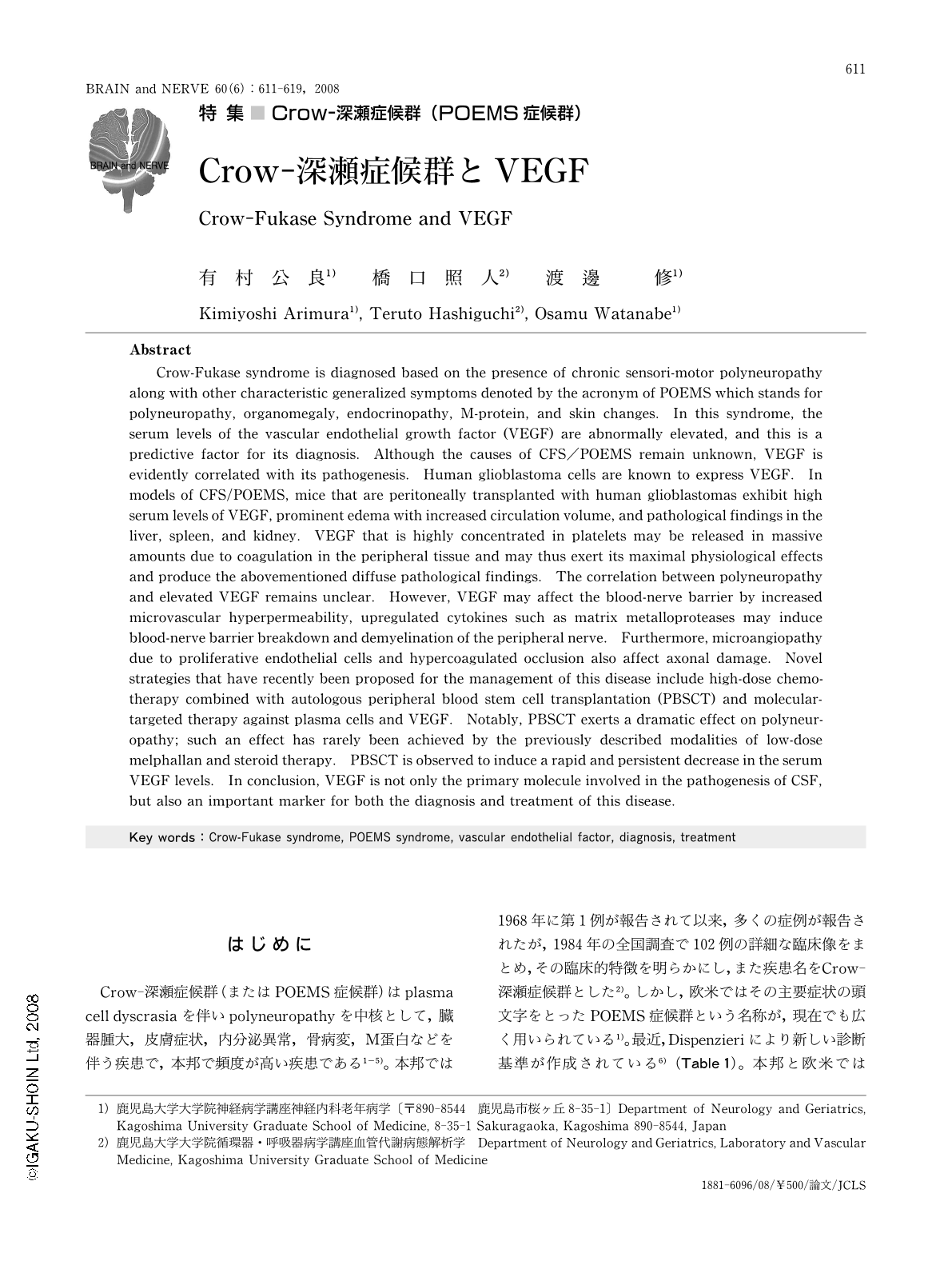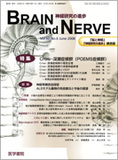Japanese
English
- 有料閲覧
- Abstract 文献概要
- 1ページ目 Look Inside
- 参考文献 Reference
はじめに
Crow-深瀬症候群(またはPOEMS症候群)はplasma cell dyscrasiaを伴いpolyneuropathyを中核として,臓器腫大,皮膚症状,内分泌異常,骨病変,M蛋白などを伴う疾患で,本邦で頻度が高い疾患である1-5)。本邦では1968年に第1例が報告されて以来,多くの症例が報告されたが,1984年の全国調査で102例の詳細な臨床像をまとめ,その臨床的特徴を明らかにし,また疾患名をCrow-深瀬症候群とした2)。しかし,欧米ではその主要症状の頭文字をとったPOEMS症候群という名称が,現在でも広く用いられている1)。最近,Dispenzieriにより新しい診断基準が作成されている6)(Table1)。本邦と欧米ではCrow-深瀬症候群の診断には大きな差はないが,若干疾患の捉え方が異なっている。それは本邦ではpolyneuropathy+特徴的な臨床症状の組み合わせを重視するのに対し,欧米ではpolyneuropathy+plasma cell proliferative disorderを診断の最重要項目としている点にある。1984年と2004年の日本の全国調査結果では,それぞれ骨病変(54%,58%),M蛋白血症(75%,89%)と,本邦では必ずしも形質細胞の増殖を確認できない症例が少なからず存在している6,7)(Table2)。現在,桑原らを中心に日・米で共通の診断基準の作成が進められている。このような診断基準の問題からもわかるように,Crow-深瀬症候群は多発神経炎以外の特徴的な全身症状がそろわない場合には,ときに診断が遅れることがある。最近,後で述べる自己末梢血幹細胞移植(autologus peripheral blood stem cell transplant: APBSCT)+高用量化学療法が著効を示すことが相次いで報告されており,的確な診断のもと早期に治療を行う傾向にある。このため臨床症状だけでなく,Crow-深瀬症候群に比較的特異的な診断マーカーが必要であったが,血清VEGF(vascular endothelial growth factor)がそのマーカーとなりうることが明らかになった。
Abstract
Crow-Fukase syndrome is diagnosed based on the presence of chronic sensori-motor polyneuropathy along with other characteristic generalized symptoms denoted by the acronym of POEMS which stands for polyneuropathy, organomegaly, endocrinopathy, M-protein, and skin changes. In this syndrome, the serum levels of the vascular endothelial growth factor (VEGF) are abnormally elevated, and this is a predictive factor for its diagnosis. Although the causes of CFS/POEMS remain unknown, VEGF is evidently correlated with its pathogenesis. Human glioblastoma cells are known to express VEGF. In models of CFS/POEMS, mice that are peritoneally transplanted with human glioblastomas exhibit high serum levels of VEGF, prominent edema with increased circulation volume, and pathological findings in the liver, spleen, and kidney. VEGF that is highly concentrated in platelets may be released in massive amounts due to coagulation in the peripheral tissue and may thus exert its maximal physiological effects and produce the abovementioned diffuse pathological findings. The correlation between polyneuropathy and elevated VEGF remains unclear. However, VEGF may affect the blood-nerve barrier by increased microvascular hyperpermeability, upregulated cytokines such as matrix metalloproteases may induce blood-nerve barrier breakdown and demyelination of the peripheral nerve. Furthermore, microangiopathy due to proliferative endothelial cells and hypercoagulated occlusion also affect axonal damage. Novel strategies that have recently been proposed for the management of this disease include high-dose chemotherapy combined with autologous peripheral blood stem cell transplantation (PBSCT) and molecular-targeted therapy against plasma cells and VEGF. Notably, PBSCT exerts a dramatic effect on polyneuropathy; such an effect has rarely been achieved by the previously described modalities of low-dose melphallan and steroid therapy. PBSCT is observed to induce a rapid and persistent decrease in the serum VEGF levels. In conclusion, VEGF is not only the primary molecule involved in the pathogenesis of CSF, but also an important marker for both the diagnosis and treatment of this disease.

Copyright © 2008, Igaku-Shoin Ltd. All rights reserved.


